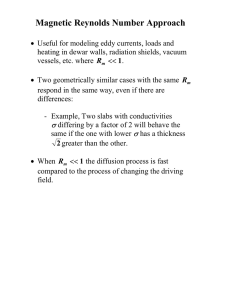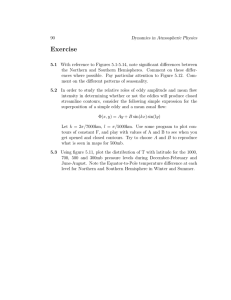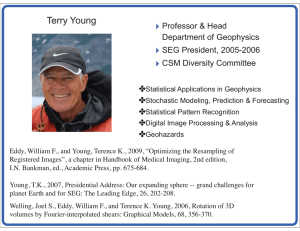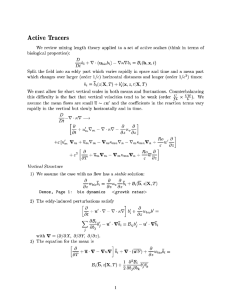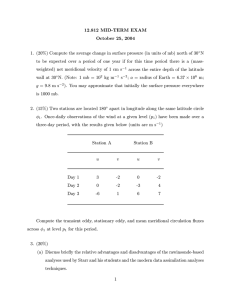The Kinematics of Mesoscale Eddies from TOPEX/Poseidon Altimetry over the Subtropical
advertisement
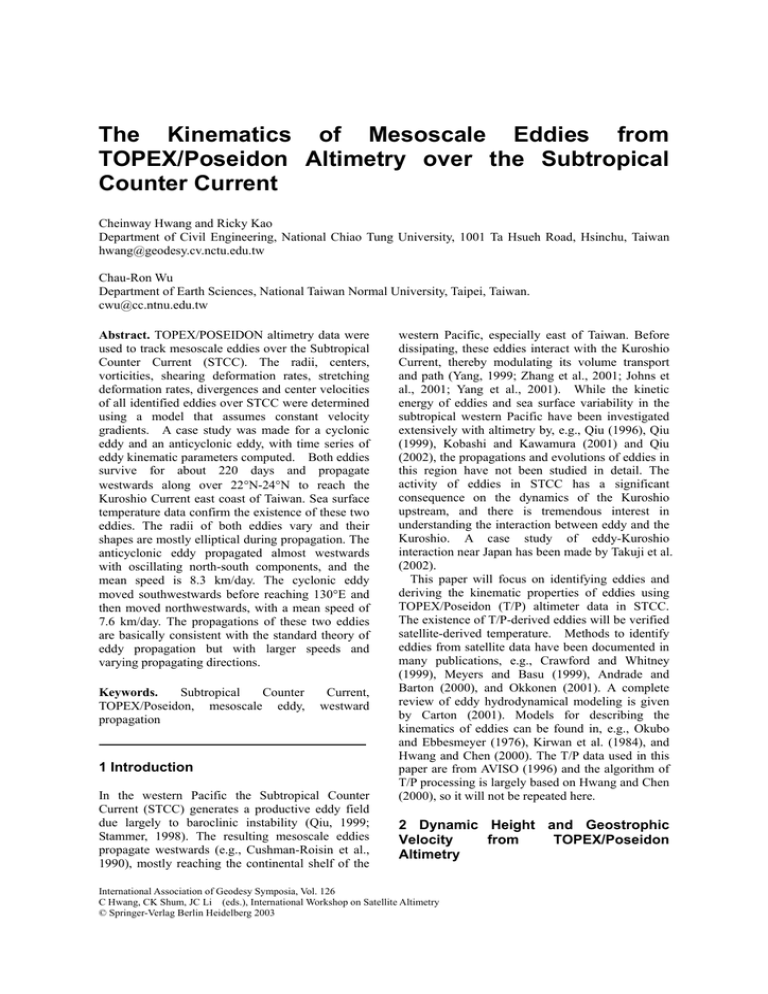
The Kinematics of Mesoscale Eddies from TOPEX/Poseidon Altimetry over the Subtropical Counter Current Cheinway Hwang and Ricky Kao Department of Civil Engineering, National Chiao Tung University, 1001 Ta Hsueh Road, Hsinchu, Taiwan hwang@geodesy.cv.nctu.edu.tw Chau-Ron Wu Department of Earth Sciences, National Taiwan Normal University, Taipei, Taiwan. cwu@cc.ntnu.edu.tw Abstract. TOPEX/POSEIDON altimetry data were used to track mesoscale eddies over the Subtropical Counter Current (STCC). The radii, centers, vorticities, shearing deformation rates, stretching deformation rates, divergences and center velocities of all identified eddies over STCC were determined using a model that assumes constant velocity gradients. A case study was made for a cyclonic eddy and an anticyclonic eddy, with time series of eddy kinematic parameters computed. Both eddies survive for about 220 days and propagate westwards along over 22°N-24°N to reach the Kuroshio Current east coast of Taiwan. Sea surface temperature data confirm the existence of these two eddies. The radii of both eddies vary and their shapes are mostly elliptical during propagation. The anticyclonic eddy propagated almost westwards with oscillating north-south components, and the mean speed is 8.3 km/day. The cyclonic eddy moved southwestwards before reaching 130°E and then moved northwestwards, with a mean speed of 7.6 km/day. The propagations of these two eddies are basically consistent with the standard theory of eddy propagation but with larger speeds and varying propagating directions. Keywords. Subtropical Counter TOPEX/Poseidon, mesoscale eddy, propagation Current, westward 1 Introduction In the western Pacific the Subtropical Counter Current (STCC) generates a productive eddy field due largely to baroclinic instability (Qiu, 1999; Stammer, 1998). The resulting mesoscale eddies propagate westwards (e.g., Cushman-Roisin et al., 1990), mostly reaching the continental shelf of the western Pacific, especially east of Taiwan. Before dissipating, these eddies interact with the Kuroshio Current, thereby modulating its volume transport and path (Yang, 1999; Zhang et al., 2001; Johns et al., 2001; Yang et al., 2001). While the kinetic energy of eddies and sea surface variability in the subtropical western Pacific have been investigated extensively with altimetry by, e.g., Qiu (1996), Qiu (1999), Kobashi and Kawamura (2001) and Qiu (2002), the propagations and evolutions of eddies in this region have not been studied in detail. The activity of eddies in STCC has a significant consequence on the dynamics of the Kuroshio upstream, and there is tremendous interest in understanding the interaction between eddy and the Kuroshio. A case study of eddy-Kuroshio interaction near Japan has been made by Takuji et al. (2002). This paper will focus on identifying eddies and deriving the kinematic properties of eddies using TOPEX/Poseidon (T/P) altimeter data in STCC. The existence of T/P-derived eddies will be verified satellite-derived temperature. Methods to identify eddies from satellite data have been documented in many publications, e.g., Crawford and Whitney (1999), Meyers and Basu (1999), Andrade and Barton (2000), and Okkonen (2001). A complete review of eddy hydrodynamical modeling is given by Carton (2001). Models for describing the kinematics of eddies can be found in, e.g., Okubo and Ebbesmeyer (1976), Kirwan et al. (1984), and Hwang and Chen (2000). The T/P data used in this paper are from AVISO (1996) and the algorithm of T/P processing is largely based on Hwang and Chen (2000), so it will not be repeated here. 2 Dynamic Height and Geostrophic Velocity from TOPEX/Poseidon Altimetry International Association of Geodesy Symposia, Vol. 126 C Hwang, CK Shum, JC Li (eds.), International Workshop on Satellite Altimetry © Springer-Verlag Berlin Heidelberg 2003 Cheinway Hwang et al. In order to track eddies in STCC, we first computed relative dynamic heights from T/P sea surface height (SSH) data. Because the steric anomaly in the open oceans consists of mainly long wavelength components and because we intend to identify only mesoscale eddies, sea level anomaly (SLA), defined as the difference between instantaneous SSH (without ocean tide effect) and a mean SSH, can be regarded as relative dynamic height; see also the discussion in Wunsch and Stammer (1998). Considering only the balance between pressure gradient and Coriolis force, the geostrophic velocity components can be derived from the gradients of dynamic heights as: g ∂ζ g ∂ζ =− f ∂y f R∂φ (1) g ∂ζ g ∂ζ = f ∂x f R cos φ∂λ (2) u=− v= geostrophic velocity fields to identify eddies in STCC, as was done in Hwang and Chen (2000); other relevant techniques of eddy identification can be found in, e.g., Gründlingh (1995), Siegel et al. (1999), Crawford and Whitney (1999). Methods for automatic extraction of features like eddies are, e.g., wavelet decomposition and gradient analysis (Förstner, 2000). However, it will be difficult even if possible to use automatic methods to identify eddies in STCC due to the complex ocean-land boundaries here. We adopted the 5-cm contour line in dynamic height as the edge of an eddy, and then estimated the coordinates of its center and radius. The type of eddy (cyclonic or anticyclonic) is determined by visual inspection of the rotation directions. The acceptance of this eddy, as well as the determination of the eddy’s kinematic properties, will be made in the least-squares methods described below. To see how an eddy evolves in STCC, we modify the approach of Sanderson (1995) to compute its center velocity, vorticity and deformation rates. First, in a local Cartesian x, y coordinate system, the gradients of geostrophic velocity components are where u, v are west-east and north-south components of velocities, ζ is relative dynamic height, g is gravity ( ≈ 9.8 m sec -2 ), φ , λ are latitude and longitude, f= 2Ω sin φ with g 11 = Ω ≈ 7.292115 × 10 −5 s −1 , and R is mean earth radius ( ≈ 6371 km ). In using (1) and (2) for deriving eddy velocities, the effects of centrifugal force and frictions are neglected, and this is valid for a vortex of large size (radius more than 100 km) (cf: Cushman-Roisin, 1994). Using (1) and (2) we have computed the geostrophic velocity fields over STCC at each T/P cycle up to early 2002. In the computations the two gradient components of dynamic height needed in (1) and (2) were obtained by first fitting a second-degree polynomial to the dynamic height grid, and then evaluating the differentiations using the derivatives of the polynomials. The dynamic height grids were constructed using the minimum curvature module in the GMT package (Wessel and Smith, 1995). To reduce data noise and aliasing effect caused by the uneven along-track and cross-track data spacings, we applied a Gaussian filter with a full window width of 300 km (see Wessel and Smith (1995) for these definitions) to dynamic heights on the grids. ∂u ∂u ∂v ∂v , g 12 = , g 21 = , g 22 = (3) ∂x ∂y ∂x ∂y Within a 10-day period, it is assumed that g11 , g 12 , g 21 , and g 22 are constants with respect to location and time. Using these gradients, we cane determine vorticity, shearing deformation rate, stretching deformation rate, and finally the divergence as Ω = g 21 − g12 , γ 1 = g 21 + g 12 γ 2 = g 11 − g 22 ,ψ = g 11 + g 22 (4) The vorticity defined in (4) is twice the angular velocity. By definition, in the northern hemisphere the vorticity is positive for a cyclonic (cold-cored, or low-pressure) eddy, and is negative for an anticyclonic (warm-cored, or high-pressure) eddy. Regarding an eddy as a single point, the definitions of shearing and stretching deformation rates are the same as those defined in geophysical literature dealing with surface deformation; see Rikitake (1976) and Lambeck (1988). Also, the total 3 Method for Determination of Eddy Kinematic Properties deformation rate of an eddy is γ = γ 12 + γ 22 (Carton, 2001, p. 220). A positive/negative stretching deformation rate We used the contours of dynamic heights and the 184 The Kinematics of Mesoscale Eddies from TOPEX/Poseidon Altimetry over the Subtropical Counter Current indicates extension/compression in the west-east direction and compression/extension in the south-north direction. In the case of a positive stretching deformation rate, a circular eddy becomes an ellipse with the semi-major axis lying in the west-east direction. Furthermore, a positive/negative shearing deformation rate indicates extension/compression in the northeast-southwest direction and compression/extension in the northwest-southeast direction. Similarly, if shearing deformation rate is positive, then a circular eddy becomes elliptical with the semi-major axis lying in the northeast-southwest direction. The velocity of a particle i at any location within an eddy is expressed as the sum of the instantaneous center velocity and the incremental velocity due to velocity gradient, that is, u i + eui = g 11 [x i − x 0 ] + g 12 [ y i − y 0 ] + u c v i + e vi = g 21 [x i − x 0 ] + g 22 [ y i − y 0 ] + v c where vector β 0 contains the approximate values and vector ∆β contains the corrections. Expanding (5) and (6) into Taylor series and retaining only the first-order terms, we obtain in a matrix representation V = A∆β − L where V is a vector containing eui and e vi , A is the design matrix, and L is a vector containing u i , vi . Specifically, the elements in V, A, and L are [ V = eu1 e v1 L eun e vn 0 y − y0 0 x1 − x0 1 0 0 M M x − x0 y − y 0 0 0 n n 0 0 (6) β = β 0 + ∆β T (9) 0 0 x1 − x00 y1 − y00 M M 0 0 xn − x00 yn − y00 0 − g12 1 0 0 0 1 − g 22 M M M M 0 0 1 0 − g11 − g12 0 0 0 1 − g 21 − g 22 0 − g11 0 − g 21 (10) xi , y i are coordinates of components, particle, x 0 , y 0 are coordinates of eddy center and n is number of data points. The kinematic parameters of an eddy to be estimated are g 11 , g 12 , g 21 , g 22 , x 0 , y 0 , u c , and v c . In comparison to the model of Hwang and Chen (2000), the model in (5) and (6) takes into account the instantaneous velocity of eddy center, which must be considered in view of the westward propagation of an eddy, see also Cushman-Roisin et al. (1990). The instantaneous velocity is relative to the surrounding water of the eddy. In the practical computations, a preliminary radius of a given eddy is estimated from the dynamic height field. The velocity components in (5) and (6) are sampled on a 0.25° × 0.25° grid within the eddy, which is defined to be a circle of the preliminary radius. We use the least-squares method to solve for the kinematic parameters. Because (5) and (6) are nonlinear with respect to the kinematic parameters, it is necessary to use iterations in the least-squares estimation. Let vector uc ] A= (5) where u i , v i are velocity components of particle, eui , e vi are residuals of velocity β = [g 11 g 12 g 21 g 22 x 0 y 0 tain the kinematic parameters and (8) [ L = u1 − u10 v1 − v10 L u n − u n0 v n − v n0 ] T (11) 0 0 0 0 where g 11 , g 12 , g 21 , g 22 , x 00 , y 00 , u c0 , and v c0 are the approximate values of the kinematic parameters, u i0 , and v i0 are the computed velocities obtained by substituting the approximate values into (5) and (6); see, e.g., also Hwang and Chen (2000) for the detail of computing β 0 . The instantaneous velocity u c , v c are taken to be zero initially. Solution was of β is done by least-squares with iteration (Hwang and Chen, 2000). It was found that we may reach ∆β i / β i ≈ 10 −7 after about three iterations, where ∆β i and β i are the elements of vectors ∆β and β , respectively. 4 Tracking an Anticyclonic Eddy Figure 1 displays successive motions of a warm-cored eddy at a 10-day interval using the contours of dynamic height. For convenience this eddy is named Eddy 155-177 (because it is identified using T/P data from cycles 155 to 177). On about October 29, 1996, the periphery of Eddy v c ] con T (7) 185 Cheinway Hwang et al. moving local highs at about the same locations of Eddy 155-177. The temperature near the eddy center is about 0.5°C higher than the temperature of the surrounding water. If we regard the zero-contour in Figure 2 as the edge of Eddy 155-177, then the estimated radii are about 200-300 km, similar to those shown in Figure 1. Both the dynamic heights in Figure 1 and the SSTA in Figure 2 show that the center of Eddy 155-177 was located at about latitude = 23 ゚ N and longitude = 137.5°E on November 27, 1996, and the center moved to latitude = 23 ° N and longitude = 133.5 ° E on January 22, 1997. This leads to an averaged propagating speed of about 7 km day-1 for Eddy 155-177. This estimate is slightly smaller than 8.3 km day-1 from dynamic height, and the difference may have been due to use of different time spans. Furthermore, Figure 2 shows a band of temperature high along the path of the Kuroshio east of Taiwan. Here the temperature is about 0.5-1°C higher than the surrounding water. 155-177 was visible near 140°E. It then moved westwards to be completely inside STCC on about November 18, 1996. While propagating, the shape and size of Eddy 155-177 vary and it is mostly not circular. From December 17, 1996 on, Eddy 155-177 was free from the influence of other water mass, and its shape became nearly circular. On April 25, 1997, Eddy 155-177 met another anticyclonic eddy and its speed became nearly zero. On June 4, 1997, Eddy 155-177 merged with another eddy to form a new eddy; this new eddy disappeared all together later. The averaged propagating speed is 8.3 km day-1. In total, Eddy 155-177 travels a distance of 1814 km in 218 days in STCC. Fig. 1 Contours of dynamic height associated with Eddy 155-177 at a 10-day interval from October 29, 1996 to July 14, 1997. Dotted lines show T/P tracks. To verify Eddy 155-177, we obtained sea surface temperature anomaly (SSTA) from Integrated Global Ocean Services System (IGOSS) at the world wide web site http://ingrid.ldeo.columbia.edu/SOURCES/.IGOSS/ .nmc/.Reyn_SmithOIv1/.weekly.The SSTA data at IGOSS are on a 1°×1° grid and are a combination of in-situ measurements and temperatures derived from the Advanced Very High Resolution Radiometer (AVHRR) of the National Oceanic and Atmospheric Administration (NOAA). The SSTA grids were constructed from scattering temperature data by an optimal interpolating scheme; see also Reynolds and Smith (1994). Figure 2 shows a sequence of SSTA images and contours at a 7-day interval from November 27, 1996 to January 22, 1997, overlapping 63 days with T/P dynamic heights in Figure 1. The SSTA in Figure 1 show Fig. 2 Sea surface temperature anomalies at a 7-day interval from November 27, 1996 to January 22, 1997, corresponding to Eddy 155-177. Table 1. Mean values and variabilities of kinematic parameters for Eddy 155-177 and Eddy 244-268 Parameters Eddy Eddy 244-268 155-177 Cent. vel. (km day-1) 3.795/1.845 3.181/2.519 Vor. (µrad s-1) -2.098/0.633 1.513/0.539 -1 -0.021/0.314 0.053/0.570 Shear (µrad s ) -0.174/0.367 -0.222/0.376 Stretch (µrad s-1) 0.015/0.046 0.001/0.061 Diver. (µrad s-1) Radius (km) 273/42 240/49 Latitude (°N) 22.629/0.200 23.074/0.766 186 The Kinematics of Mesoscale Eddies from TOPEX/Poseidon Altimetry over the Subtropical Counter Current Figure 3 shows the radii, the center coordinates and propagating velocities of Eddy 155-177 at a 10-day interval; the mean values and variabilities of the kinematic parameters for Eddy 155-177 are given in Table 1. From Figure 3 and Table 1, Eddy 155-177 propagated westwards in a narrow zonal band centering at 22.629°N. The averaged radius of Eddy 155-177 is 273 km. Eddy 155-177 moved southwestwards from cycle 155 to 177, from cycle 163 to 166 and from cycle 170-174 and at other times Eddy 155-177 traveled almost zonally. Basically the propagation of this anticyclonic eddy is consistent with what the theory predicts: an anticyclonic eddy propagates southwestwards (Cushman-Roisin, 1994). Fig. 5 Contours of dynamic height associated with Eddy 244-268 at a 10-day interval from March 20, 1999 to January 2, 2000. Dotted lines show T/P tracks. Figure 4 shows time series of vorticity, shearing deformation rate, stretching deformation rate, and divergence of Eddy 155-177. The vorticity remains relatively steady during the propagation and it dropped as Eddy 155-177 approached the east coast of Taiwan. Its divergence is nearly zero and was quite steady during the entire lifetime, indicating little loss of eddy fluid during the propagation. The shearing and stretching deformation rates oscillate around zero and both have about the same magnitudes. 5 Tracking a Cyclonic Eddy Fig. 3 Radii (top), center coordinates (middle) and propagating velocities (bottom) of Eddy 155-177. Figure 5 shows the contours of dynamic height associated a cyclonic eddy, named Eddy 244-268, at a 10-day interval from March 20, 1999 to January 2, 2000. The first sign of this cold-cored eddy occurred on March 30, 1999 and its radius was small. This eddy became full–fledged 90 days later (on May 9, 1999), and then it began to move southwestwards. Like the warm-cored eddy in the previous section, the shape and course vary while Eddy 244-268 is in motion. The shapes become particularly irregular when Eddy 244-268 reaches the Kuroshio east of Taiwan. This cyclonic eddy has an average propagating speed of 7.6 km day-1 and travels a distance of 1816 km in 238 days. Again Eddy 244-268 is verified by temperature data. Figure 6 shows radii, center coordinates and propagating velocities of Eddy 244-268. Figure 7 show the time series of the estimated kinematic parameters and standard errors of Eddy 244-268. Fig. 4 Time series of vorticity (circle), shearing deformation rate (triangle), stretching deformation rate (inverted triangle), divergence (cross), standard errors of vorticity and deformation (square) of Eddy 155-177. Days are counted from Oct 29, 1996. 187 Cheinway Hwang et al. Again, a significance test (Koch, 1987) using the estimated parameters and standard errors shows that all the estimated parameters are significant (or non-zero). Figures 6 and 7 are to be compared with Figures 3 and 4. At the early stage, Eddy 244-268 has a southward component of velocity. We also computed the mean values and variabilities of kinematic parameters for Eddy 244-268, which are given in Table 1. Compared to Eddy 155-177, Eddy 244-268 has a slightly smaller instantaneous velocity. The vorticity of the cyclonic eddy is also smaller than that of the anticyclonic eddy. From the variabilities of latitude, the propagation of the cyclonic eddy follows a broader zonal band than that of the anticyclonic eddy. This broader zonal band is clearly seen in Figure 6, which shows that Eddy 244-268 emerged at latitude near 24 ° N, moved southwards to 22°N and then moved back to 23 ° N. Also, Eddy 244-268 has larger shearing deformation rate and stretching deformation rate than those of Eddy 155-177, indicating that the flattening of Eddy 244-268 is larger than that of Eddy 155-177. The averaged radius of the Eddy 244-268 is smaller than that of Eddy 155-177, but the variabilities of the radii of the two eddies are almost the same. Interestingly, the divergence of the cyclonic eddy is an order of magnitude smaller than that of the anticyclonic eddy although both of them are nearly zero. This means that Eddy 244-268 lost less fluid than Eddy 155-177 during the propagation. Both eddies have larger vorticities when they reached east of Taiwan. The origins of Eddies 155-177 and 244-268 are possibly due to baroclinic instability. This is shown in Qiu (1999) and Kobashi and Kawamura (2002). Theoretical studies of baroclinic instability associated with eddies can be found in, e.g., Cushman-Roisin (1994), and Olascoaga and Ripa (1999). Cushman-Roisin (1994, p. 227) shows that, in a stratified system, lateral displacements in the geostrophic flow cause vertical stretching and squeezing, which generate a cyclonic vortex or an anticyclonic vortex, or both. Such a vortex will then evolve away from the initial state. In the STCC area, a vortex originating from baroclinic instability will move westwards, as demonstrated by the theory of Nof (1983) and the T/P observations in this paper. p.256), the migration of a mesoscale eddy is primarily induced by the varying thickness of the layer surrounding the eddy. This primary effect introduces a westward motion of eddy for cyclonic and anticyclonic eddies in the northern hemisphere. In general, the motion of both Eddy 155-177 and Eddy 244-268 are consistent with such a predicted motion, since in most cases they move westwards. Fig. 6 Radii (top), center coordinates (middle) and propagating velocities (bottom) of Eddy 244-268. Fig. 7 Time series of vorticity (circle), shearing deformation (triangle), stretching deformation (inverted triangle), divergence (cross), standard errors of vorticity and deformation (square) of Eddy 244-268. Days are counted from March 20, 1999. 6 Discussions Moreover, the warm Eddy 155-177 retreated and migrated northwards when reaching 123˚E near a steep bottom slope. This phenomenon has been confirmed by numerical experiments. Based on a The propagation mechanism of mesoscale eddies has been discussed in, e.g., Nof (1983), Cushman-Roisin et al. (1990), and Cushman-Roisin (1994). As demonstrated in Cushman-Roisin (1994, 188 The Kinematics of Mesoscale Eddies from TOPEX/Poseidon Altimetry over the Subtropical Counter Current propagations and evolutions. The degree of deformation is proportional to the magnitude of deformation rate. The shearing and stretching deformation rates oscillate around zero. Based on the interpretation of deformation rates, the change of sign indicates that the major axes of the two eddies rotate during propagation. The shearing deformation rate of Eddy 244-268 oscillates rapidly, suggesting its shape also changes rapidly. Eddy 244-268’s stretching deformation rate goes slowly from negative to zero and change the sign back to negative. When the deformation rate is nearly zero, the shape of an eddy then approaches circle. There is a tendency that the deformation will approach zero. Such a tendency brings the shape from ellipse to circle and is called axis-symmetrization (Carton, 2001). Due to the influence of the ambient fluid a circular eddy will be deformed and its shape becomes elliptical again. This process is repeated and that’s why we see the deformation rates oscillate around zero. primitive equation model, Itoh and Sugimoto (2001) show that warm-core rings that initially have baroclinic velocity would move northward while approaching a steep bottom topography of a western boundary. Interestingly, cold Eddy 244-268 also contains northward velocity component when reaching 123˚E, but its northward component is not as evident as Eddy 155-177. Another interesting feature of Eddy 244-268 is that it moves southwards dramatically at around 130 ˚E (Figure 6), where Eddy 244-268 interacted with a newly formed eddy to the south (Figure 5). Merging and mutual advection between Eddy 244-268 and the new eddy resulted in a southward motion. This merging process also supplied these eddies with energy and vorticity (Yasuda, 1995). Eddy 244-268 gradually moves northwards after merging. Cushman-Roisin (1994) predicts that a secondly drift originating from the advection of surrounding fluid of an eddy will introduce a northward motion for a cyclonic eddy. Therefore, in theory a cyclonic eddy will move westwards or northwestwards. The northwestward motion of cold Eddy 244-268 again is consistent with the theory of Cushman-Roisin (1994). On the other hand, the observed propagating speeds of the two eddies are larger than the predicted speeds. Such a difference between observation and theory is also found in the propagations of eddies near Hawaii (Holland and Mitchum, 2001). Many factors contribute to the difference between theory and observation, e.g., interaction of eddies, bottom topography, the effect of mean flow, and long wave propagation. The averaged propagating velocity of 8 km day-1 is quite consistent with the observed velocities of Rossby wave in, e.g., Chelton and Schlax (1996), Dewar (1998) and Cipollini et al. (2000). Furthermore, Liu et al. (2001) has presented a detailed analysis of Rossby waves in STCC and pointed out a 90-day oscillation in sea surface height associated with long Rossby wave with wavelengths ranging from 450 to 840 km. That is, Rossby wave occurs about every 90 days and it should have a great consequence on eddies in STCC. Therefore, it is hypothesized that the two eddies under study may happen to “take a ride” on the concurring Rossby waves and the propagating velocities in Figure 6 are actually the velocities of Rossby waves. Future work should explore this hypothesis by numerical modeling. Eddies 155-177 and 244-268 have deformation rates that are non zero in most cases, indicating that their shapes are largely not circular during the 7 Conclusions This paper presents a method for determining the kinematic properties of mesoscale eddies based on the principle of constant velocity gradients and instantaneous center velocity. In such a model, the deformation rates are determined and can be used to see the shape evolution of an eddy during its lifetime. An anticyclonic and a cyclonic eddy are studied using this method and their existences are verified by temperature data and drifter data. This is the first time an anticyclonic and a cyclonic eddy are completely tracked during their lifetimes in STCC. The two eddies propagate westwards with an averaged speed of about 8 km day-1 and their shapes are not circular in most cases. The north-south directions of propagations of the two eddies do not follow exactly what the theories of Nof (1983) and Cushman-Roisin et al. (1990) have predicted, and the propagation speeds are larger than the theoretical speeds. It is very likely that the two eddies propagate with Rossby waves, which themselves also have speeds larger than what theories have predicted, see, e.g., Chelton and Schlax (1996) and Dewar (1998). The estimated kinematic parameters can be used to verify results in an eddy-resolving model of ocean circulation. Acknowledgements. This research is supported by the National Science Council of Taiwan, Republic of China, under contract NSC89-2611-M-009 –003 -OP2. 189 Cheinway Hwang et al. Nof, D. (1983). On the Migration of Isolated Eddies with Application to Gulf Stream Rings, J Mar Res, 41, pp. 399-425. Okkonen, S. R. (2001). Altimeter Observations of Bering Slope Current Eddy Field, J Geophys Res, 106, pp. 465-2,476. Okubo, A., and C. C. Ebbesmeyer (1976). Determination of Vorticity, Divergence, and Deformation Rates from Analysis of Drogue Observations, Deep-Sea Res, 23, pp. 349-352. Olascoaga, M. J. and P. Ripa (1999). Baroclinic Instability in a Two-Layer Model with a Free Boundary and β Effect, J Geophys Res, 104, pp. 23357-23366. Qiu, B., and R. Lukas (1996). Seasonal and Interannual Variability of the North Equatorial Current, the Mindanao Current, and The Kuroshio along the Pacific Western Boundary, J Geophys Res, 101, pp. 12315-12330. Qiu, B. (1999). Seasonal Eddy Field Modulation of the North Pacific Subtropical Countercurrent: TOPEX/POSEIDON Observations and Theory, J Phys Oceanogr, 29, pp. 2471-2486. Qiu, B. (2002). Large-scale Variability in the Midlatitude Subtropical and Subpolar North Pacific Ocean: Observations and Causes, J Phys Oceanogr, 32, pp. 353-375. Reynolds, R. W., and T. M. Smith (1994). Improved Global Sea Surface Temperature Analyses, J Clim, 7, pp. 929-948. Rikitake, T. (1976). Earthquake Prediction, Elsevier, Amsterdam. Sanderson, B. G. (1995). Structure of an Eddy Measured with Drifters, J Geophys Res, 100, pp. 6761-6776. Siegel, D. A., D. J. McGillicuddy Jr, and E. A. Fields (1999). Mesoscale Eddies, Satellite Altimetry and New Production in the Sargasso Sea, J Geophys Res, 104, pp. 13359-13380. Stammer, D. (1998). On Eddy Characteristics, Eddy Transports and Mean Flow Properties, J Phys Oceanogr, 28, pp. 727-739. Takuji, W., H. Mitsudera, B. Taguchi, and Y. Yoshikawa (2002). On the Eddy-Kuroshio Interaction: Evolution of the Mesoscale Eddy, J Geophys Res, 107 , pp. 3-1-3-19. Wessel, P., and W. H. F. Smith (1995). New Version of the Generic Mapping Tool Released, EOS, Trans. AGU, 76, pp. 329. Wunsch, C., and D. Stammer (1998). Satellite Altimetry, the Marine Geoid, and the Oceanic General Circulation, Anu. Rev. Earth Planet. Sci., 26, pp. 219-253. Yang, Y. (1999). Mesoscale Eddies’ Influence on the Taiwan Current(Kuroshio)Volume Transport, PhD Thesis, Institute of Oceanography, National Taiwan University. Yang, Y., C. T. Liu, T. N. Lee, et al. (2001). Sea Surface Slope as an Estimator of the Kuroshio Volume Transport East of Taiwan, Geophys Res Lett, 28, pp. 2461-2464. Yasuda, I. (1995). Geostrophic Vortex Merger and Streamer Development in the Ocean with Special Reference to the Merger of Kuroshio Warm Core Rings, J Phys Oceanogr, 25, pp. 979-996. Zhang, D., T. N. Lee and W. E. Johns (2001). The Kuroshio East of Taiwan: Modes of Variability and Relationship to Interior Ocean Mesoscale Eddies, J Phys Oceanogr, 31, pp. 1054-1074. References Andrade, C. A., and E. D. Barton (2000). Eddy Development and Motion in Caribbean Sea, J Geophys Res, 105, pp. 26191-26201. Archivings Validation and Interpretation of Satellite Oceanographic Data (AVISO). (1996). AVISO User Handbook for Merged TOPEX/POSEIDON Products, 3rd ed. Carton, X. (2001). Hydrodynamical Modeling of Oceanic vortices, Surv Geophys, 22, pp. 179-263. Chelton, D. B., and M. G. Schlax (1996). Global Observations of Oceanic Rossby Waves, Science, 272, pp. 235-238. Cippollini, P., D. Cromwell, G. D. Quartly, and P. G. Challenor (2000). Remote Sensing of Oceanic Extra-tropical Rossby Waves, Satellites, Oceanography and Society, edited by D. Halpern, pp. 99-124. Crawford, W. R., and F. A. Whitney (1999). Mesoscale Eddy Aswirl with Data in Gulf of Alaska, EOS, Trans., AGU, 80, pp. 365. Cushman-Roisin, B., E. P. Chassignet, and B. Tang (1990). Westward Motion of Mesoscale Eddies, J Phys Oceangr, 20, pp. 758-768. Cushman-Roisin, B. (1994). Introduction to Geophysical Fluid Dynamics, Prentice Hall, New Jersey. Dewar, W. K. (1998). On “too fast” Baroclinic Planetary Waves in The General Circulation, J Phys Oceanogr, 28, pp. 1739-1758. Förstner, W. (2000). Image Preprocessing for Feature Extraction in Digital Intensity, Color and Range Images, Geomatic Methods for The Analysis of Data in The Earth Sciences, edited by A. Dermanis and A Grun and F Sanso (Eds), Lecture Notes in Earth Sciences, 50, pp. 165-188. Gründlingh, M. L. (1995). Tracking Eddies in the Southeast Atlantic and Southwest Indian Oceans with TOPEX/POSEIDON, J Geophys Res, 100, pp. 24977-24986. Holland, C. L., and G. T. Mitchum (2001). Propagation of Big Island eddies, J Geophys Res, 106, pp. 935-944. Hwang, C., and S. A. Chen (2000). Circulations and Eddies over the South China Sea Derived from TOPEX/POSEIDON Altimeter Data, J Geophys Res, 105, pp. 23943-23965. Itoh, S., and T. Sugimoto (2001). Numerical Experiments on the Movement of a Warm-core Ring with the Bottom Slope of a Western Boundary, J Geophys Res, 106, pp. 26851-26862. Johns, W. E., T. N. Lee, D. Zhang, and R. Rantopp (2001). The Kuroshio East of Taiwan: Moored Transport Observations from the WOCE PCM-1 array, J Phys Oceanogr, 31, pp. 1031-1054. Kirwan, A. D., W. J. Merreil, J. K. Lewis, R. E. Whitaker, and R. Legeckis (1984). A Model for the Analysis of Drifter with an Application to a Warm Core Ring in the Gulf Stream, J Geophys Res, 89, pp. 3425-3438. Kobashi, K., and H. Kawamura (2001). Variation of Sea Surface at Periods of 65-220 Days in The Subtropical Gyre of The North Pacific, J Geophys Res, 106,pp. 26817-26831. Kobashi, F., H. Kawamura (2002). Seasonal Variation and Instability Nature of the North Pacific Subtropical Countercurrent and the Hawaiian Lee Countercurrent, J Geophys Res, 107. Koch, K. R. (1987). Parameter Estimation and Hypothesis Testing in Linear Models, Springer, Berlin. Lambeck, K. (1988). Geophysical Geodesy, Clarendon Press, Oxford. Liu, Q. Y., S. X. Wang, Z. Y. Liu and H. J. Yang (2001). Dynamic Features of Long Rossby Wave in the North Pacific Subtropical Countercurrent, Chinese J Geophys, 44, pp. 28-37. Meyers, S. D., and S. Basu (1999). Eddies in the Eastern Gulf of Alaska from TOPEX/POSEIDON Altimetry, J Geophys Res, 104, pp. 13333-13344. 190
